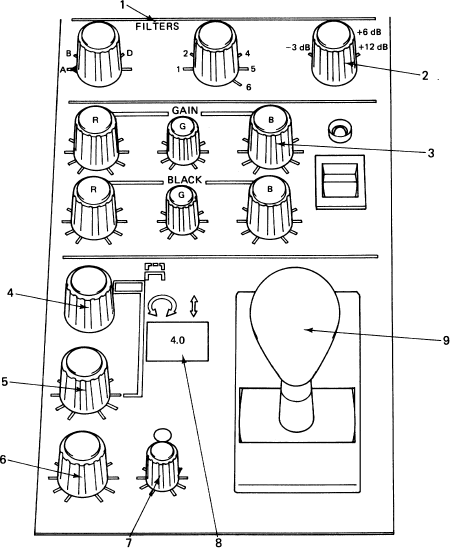Vision Control
It is important that the cameras are adjusted to produce the best possible pictures for each shot, and also to ensure that the shots match from camera to camera and from shot to shot, e.g. face tones look the same. This is the basic function of vision control.
Lightweight cameras
Lightweight cameras usually have auto-white balance, auto-black level and auto-iris facilities, three of the main areas of interest for vision control. It should be remembered that the auto-iris control can give rise to errors when the camera is presented with scenes containing large areas of excessive highlights, e.g. white clouds. Ideally the camera operator should adjust the lens iris manually to suit each shot, using the viewfinder to judge the correct exposure.
Full-facility vision control
Cameras equipped with remote control of camera processing (such as iris, black level, gamma correction, fine detail enhancement, and colour correction in highlight and black areas) will enable the vision controller to achieve greater precision in control of picture quality and ensure that the pictures match one shot to the next. This is important even when shooting ‘single camera’. At the beginning of rehearsal the camera iris should be set to its nominal value (see page 91) and the lighting levels balanced to achieve a satisfactory picture. Minor adjustments to iris and black level are made subsequently to ensure picture matching. Some shots may require more or less fine detail correction, which should be adjusted shot by shot. Any colour cast introduced by reflection of light from costumes or the set can be removed by means of the colour correction controls, and similarly for any variation in the colour temperature (whiteness) of the light sources used for each scene. Alternatively, the vision controller can deliberately introduce a colour cast, and produce warm pictures or cool pictures to match the mood of the scene as appropriate.
Further duties of the vision control engineer include camera line-up, the checking of all vision sources routed to the switcher, alignment of all the picture monitors in the studio control complex, and as a liaison point for camera crew when technical problems arise.
The vision controller works very closely with the lighting director, and in a small studio these duties may well be handled by one person.

This is a typical operational control panel (OCP) for a full-facilities camera.
1. Remote control of filter wheels located between lens and light-splitting system (colour correction, neutral density and effects filters).
2. Master gain control; extra gain is used when operating in low light.
3. Gain and black trims, used for minor adjustment of colour gain and black level when matching pictures.
4. Auto/manual iris control.
5. Detail enhancement.
6. Contrast control, used to modify the ‘law’, i.e. to stretch/crush appropriate parts of the grey scale.
7. Range control, adjusts the range over which the joystick will operate, and selects the mean aperture.
8. Readout of lens aperture.
9. Joystick, the main operational control, has three functions.
Twist to adjust master black level.
Forward/back to open/close iris.
Depress to switch channel to preview monitor.
